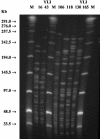virF-positive Yersinia pseudotuberculosis and Yersinia enterocolitica found in migratory birds in Sweden
- PMID: 12902256
- PMCID: PMC169077
- DOI: 10.1128/AEM.69.8.4670-4675.2003
virF-positive Yersinia pseudotuberculosis and Yersinia enterocolitica found in migratory birds in Sweden
Abstract
During spring and autumn migrations, 468 fecal samples from 57 different species of migratory birds were collected in Sweden. In total, Yersinia spp. were isolated from 12.8% of collected samples. The most commonly found species was Yersinia enterocolitica, which was isolated from 5.6% of all collected samples, followed by Y. intermedia (3.8%), Y. frederiksenii (3.0%), Y. kristensenii (0.9%), Y. pseudotuberculosis (0.6%), and Y. rohdei (0.4%). The pathogenic, virF-positive Y. pseudotuberculosis strains were recovered from three thrushes. These strains belonged to the same bioserotype, 1/O:2, but had two different profiles as determined by pulsed-field gel electrophoresis with NotI and SpeI enzymes. In addition, 10 Y. enterocolitica strains, all from barnacle geese, belonged to bioserotype 3/O:3, which is associated with human disease. Two of the strains were pathogenic, carrying the virF gene on their plasmids. All pathogenic Y. pseudotuberculosis and Y. enterocolitica strains were recovered during the spring, and as the birds were caught during active migration they likely became infected at an earlier stage of the migration, thus potentially transporting these bacterial pathogens over long geographical distances.
Figures
Similar articles
-
Evaluation of enzyme immunoassay for the detection of pathogenic Yersinia enterocolitica and Yersinia pseudotuberculosis strains.J Clin Microbiol. 1989 Apr;27(4):748-51. doi: 10.1128/jcm.27.4.748-751.1989. J Clin Microbiol. 1989. PMID: 2656747 Free PMC article.
-
Different enteropathogenic Yersinia strains found in wild boars and domestic pigs.Foodborne Pathog Dis. 2011 Jun;8(6):733-7. doi: 10.1089/fpd.2010.0711. Epub 2011 Feb 2. Foodborne Pathog Dis. 2011. PMID: 21288132
-
Pathogenic Yersinia enterocolitica 2/O:9 and Yersinia pseudotuberculosis 1/O:1 strains isolated from human and non-human sources in the Plateau State of Nigeria.Food Microbiol. 2009 Dec;26(8):872-5. doi: 10.1016/j.fm.2009.06.001. Epub 2009 Jun 10. Food Microbiol. 2009. PMID: 19835774
-
Yersiniosis in France: overview and potential sources of infection.Int J Infect Dis. 2016 May;46:1-7. doi: 10.1016/j.ijid.2016.03.008. Epub 2016 Mar 14. Int J Infect Dis. 2016. PMID: 26987478 Review.
-
Yersinia enterocolitica and Yersinia pseudotuberculosis.Clin Lab Med. 1999 Sep;19(3):523-36, vi. Clin Lab Med. 1999. PMID: 10549424 Review.
Cited by
-
Changes in Transcriptome of Yersinia pseudotuberculosis IP32953 Grown at 3 and 28°C Detected by RNA Sequencing Shed Light on Cold Adaptation.Front Cell Infect Microbiol. 2018 Nov 27;8:416. doi: 10.3389/fcimb.2018.00416. eCollection 2018. Front Cell Infect Microbiol. 2018. PMID: 30538955 Free PMC article.
-
Plasmids conferring resistance to extended-spectrum beta-lactamases including a rare IncN+IncR multireplicon carrying blaCTX-M-1 in Escherichia coli recovered from migrating barnacle geese ( Branta leucopsis).Open Res Eur. 2021 May 4;1:46. doi: 10.12688/openreseurope.13529.1. eCollection 2021. Open Res Eur. 2021. PMID: 37645149 Free PMC article.
-
Presence of Salmonella spp., Yersinia enterocolitica, Yersinia pseudotuberculosis and Escherichia coli O157:H7 in wild boars.Epidemiol Infect. 2014 Dec;142(12):2542-7. doi: 10.1017/S0950268814000119. Epub 2014 Feb 6. Epidemiol Infect. 2014. PMID: 24512817 Free PMC article.
-
Prevalence and Antimicrobial Resistance of Enteropathogenic Bacteria in Yellow-Legged Gulls (Larus michahellis) in Southern Italy.Animals (Basel). 2021 Jan 22;11(2):275. doi: 10.3390/ani11020275. Animals (Basel). 2021. PMID: 33499158 Free PMC article.
-
Sudden onset of pseudotuberculosis in humans, France, 2004-05.Emerg Infect Dis. 2008 Jul;14(7):1119-22. doi: 10.3201/eid1407.071339. Emerg Infect Dis. 2008. PMID: 18598636 Free PMC article.
References
-
- Aleksic, S., J. Bockenmühl, and H. H. Wuthe. 1995. Epidemiology of Yersinia pseudotuberculosis in Germany, 1983-1993, p. 55-58. In G. Ravagnan and C. Chiesa (ed.), Contributions to microbiology and immunology, vol. 13. Yersiniosis, present and future. Karger, Basel, Switzerland. - PubMed
-
- Anonymous. 2000. Infectious diseases in Finland 1995-1999. KTL B4/2000. National Public Health Institute, Helsinki, Finland.
-
- Baker, K. 1993. BTO guide 24. Identification guide to the European non-passerines. British Trust for Ornithology, Thetford, United Kingdom.
-
- Bub, H. 1991. Bird trapping and bird banding. Cornell University Press, Hong Kong.
Publication types
MeSH terms
Substances
LinkOut - more resources
Full Text Sources
Miscellaneous


